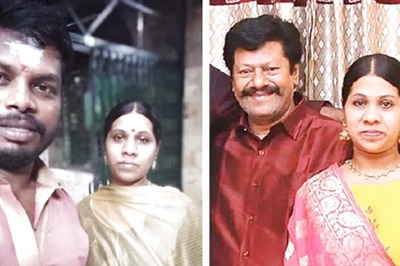
views
Preface
In his English translation of the Jain text, Uvasagadasao — compiled in the form in which it is available today — German Indologist Rudolf Hoernle recounts a common sight that he witnessed in his travels in Bengal and Odisha. In the present day, beggars may be found in Bengal who carry pictures of such deities as Shitala, goddess of smallpox, or Olabibi, goddess of cholera; in Puri, they carry pictures of Jagannatha.
The translation was published in 1890 and Hoernle had clearly spent several years preparing the book. His observation evoked hazy memories of similar scenes that I had witnessed in my own childhood in various parts of rural Karnataka and Andhra. These typically occurred in Jaatras (fairs, melas) and Sidi-Utsavas. Men and women would be squatting down or running behind people, beckoning them to see their picture scrolls. The scrolls would be neatly bound and folded and kept inside small wooden boxes, and the boxes too, had intricate carvings on them. The picture scrolls or Paṭa typically showed elaborate scenes from various Puranic stories, drawn as snug little miniatures, encased in panels. Not unlike the comic strips we are all familiar with.
Except that these Paṭas had no text accompanying or explaining the pictures. In a way, these were the mobile equivalents of the renowned Paṭa-Chitra tradition in Odisha. And the men and women who displayed them in these fairs would open up the picture scrolls and narrate the stories in animated detail, infusing impressive dramatic skills in their narration. They didn’t charge a fixed fee. I recall paying 50 paisa on one occasion. The receipt of the money was followed by an elaborate blessing in rustic poetry…invoking Shiva, Vishnu, Ganapati, or Devi. Little did I know back then that these people were professionals and the fact that they had a name and that their profession was indeed Sanatana—timeless.
They were called Mankhas.
The towering scholars, Ananda Coomaraswamy and Dr V. Raghavan translate Mankha as “picture showmen.” They were also known by other names: Gauriputraka, Kēdāraka, Yamapaṭaka, aṇḍ Pratimādharin.
Indian Art with Global Footprint
For countless centuries, Mankhas were a ubiquitous presence not just in India but abroad as well. What began as a practice and profession of exhibiting scroll pictures and paintings depicting different Puranic themes eventually became an invaluable cultural treasure.
Travellers from various countries were so awestruck and inspired by it that they spun off variations to suit their own cultures when they returned home, taking this art with them. Over time, this art form journeyed all the way to China and Brihad-Bharata (Greater India).
For example, as recent as 1416, the Chinese work, Ying-yai Sheng-lan records this scene set in Java:
“There is a sort of men who paint on paper men, birds, animals, insects and so on: the paper is like a scroll and is fixed between two wooden rollers three feet high; at one side these rollers are level with the paper, whilst they protrude at the other side. The man squats down on the ground and places the picture before him, unrolling one part after the other and turning it towards the spectators, whilst in the native language and in a loud voice he gives an explanation of every part: the spectators sit around him and listen, laughing or crying according to what he tells them.”
The Bali variant of the Mankha art form is known as Wayang Beber. It was classified by the Indonesian government as dramatic art. The artist who performs it is known as the Dalang. He unfurls several sheets of cloth containing paintings of scenes of stories from the Ramayana and the Mahabharata. Each cloth is unrolled one after the other, i.e., scene by scene, and the Dalang narrates the story behind the scenes using dialogue. Like so many such ancient art forms, Wayang Beber is also on the verge of extinction.
The art form was also popular in Persia. The meaning of the Persian word, ṣūrat-ḵẖẉān is highly revealing: “One who pictures the state of angels and men as to reward and punishment on the day of resurrection, and receives a remuneration for it from the bystanders.” This scene or painting is a direct copy of the Yamapaṭas, which were wildly popular in India for several centuries as we shall see. Interestingly, the word ṣūrat also means a puppet in Persian popular theatre, and ḵẖẉān is the reciter or singer of the story performed by the puppets. Even more incredibly, the ḵẖẉān begins the performance with an invocatory verse of an Islamic song known as the rāk-ī-hindi. The word, rāk is a corruption of the Sanskrit word, rāga. Thus, rāk-ī-hindi means “Indian tune or song.” Both the manner and modalities used in enacting this art form were almost wholly imported from classical Sanskrit theatre, complete with the Nāndi invocation at the beginning up to the Mangalam at the end.
Mankha Tradition during Colonial British Rule
The Mankha tradition survived almost intact even during colonial British rule. John Lockwood Kipling, father of the racist Rudyard Kipling, describes his experience of watching the Mankhas in action in his travelogue, Beast and Man in India.
One of the most popular of the pictures sold at fairs is a composition known as Dharmraj, a name of Yama, the Hindu Pluto, and also used broadly for Justice. The Judge is enthroned and demon executioners bring the dead to receive their doom. The river of death flows on one side of the picture and those go safely across who hold a cow by the tail, while others are torn by terrible fishes. Chitrgupt, the clerk or recording angel of Yama, considered to be the ancestor of the Kayasth or clerkly caste, sits in an office with account books exactly like those of a Hindu tradesman, and according to the record of each soul, punishments or rewards are given. For, as a popular native saying has it— “God looks out of the window of heaven and keeps account.” Duts or executioners torture offenders, while the blest sail upwards in air-borne chariots.
Kipling wrote his travelogue in 1891. Not coincidentally, it neatly corresponds to Rudolf Hoernle’s aforementioned observation in 1890. Kipling was a teacher and traveller and documenter of foreign societies while Hornle was an Indologist. Both witnessed the same India around the same period.
To be continued.
The author is the founder and chief editor, The Dharma Dispatch. Views expressed in the above piece are personal and solely that of the author. They do not necessarily reflect News18’s views.




















Comments
0 comment